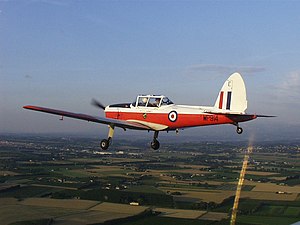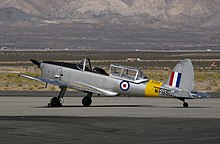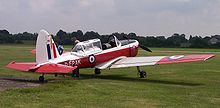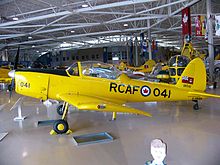de Havilland Canada DHC-1 Chipmunk
| DHC-1 Chipmunk | |
|---|---|

| |
| Privately owned DHC-1 Chipmunk F-AZSM | |
| Role | Trainer |
| Manufacturer | de Havilland Canada |
| Designer | Wsiewołod Jakimiuk |
| First flight | 22 May 1946 |
| Introduction | 1946 |
| Retired | 1972 (Canada) |
| Primary users | Royal Air Force Royal Canadian Air Force Portuguese Air Force Belgian Air Force |
| Produced | 1947-1956 |
| Number built | 1283 including Canadian, British, and Portuguese production[citation needed] |
The de Havilland Canada DHC-1 Chipmunk is a tandem, two-seat, single-engined primary trainer aircraft which was the standard primary trainer for the Royal Canadian Air Force, Royal Air Force and several other air forces through much of the post-Second World War years. The de Havilland Chipmunk was the first true postwar aviation project of de Havilland Canada.
Today, over 500 DHC-1 Chipmunk (affectionately known as "Chippie") airframes remain airworthy with more being rebuilt every year.
Design and development




The Chipmunk was designed to succeed the de Havilland Tiger Moth biplane trainer that was widely used during the Second World War. Wsiewołod Jakimiuk, a Polish prewar engineer, created the first indigenous design of the aircraft at de Havilland Aircraft of Canada Ltd. It is an all-metal, low wing, tandem two-place, single engine aircraft with a conventional tail wheel landing gear and fabric-covered control surfaces. The wing is also fabric-covered aft of the spar. A clear perspex canopy covers the pilot/student (front) and instructor/passenger (rear) positions. CF-DIO-X, the Chipmunk prototype, flew for the first time at Downsview, Toronto on 22 May 1946 with Pat Fillingham at the controls[1]. The production version of the airplane was powered by a 145 hp (108 kW) in-line de Havilland Gipsy Major 8 engine while the prototype was powered by a 145 hp (108 kW) de Havilland Gipsy Major 1C.
Two Chipmunk aircraft were evaluated by the Aeroplane and Armament Experimental Establishment (A&AEE) at RAF Boscombe Down. As a result, the fully-aerobatic Chipmunk was ordered as an ab initio trainer for the Royal Air Force (Prince Philip took his first flying lesson in one in 1952). The Royal Canadian Air Force also adopted the Chipmunk as their primary trainer.
British-built and early Canadian-built Chipmunks are notably different from the later Canadian-built RCAF/Lebanese versions. The later Canadian-built airplanes have a bubble canopy, while early Canadian, and all Portuguese and British examples have the multi-panelled sliding canopy, the rearmost panels of which are bulged for better instructor visibility.
From the 1950s onward, the Chipmunk also became a popular civilian aircraft, being used for training, aerobatics and crop spraying. Most civilian aircraft are ex-military.
Super Chipmunk
A number of Chipmunks were modified as aerobatic aircraft in the United States as the "Super Chipmunk". Along with an uprated engine, the aircraft underwent an extensive makeover including clipping its wings, adding retractable landing gear, conversion to a single-seat layout, adding an autopilot and being fitted with a red, white and blue wingtip and tail smoke system. The control stick received a three-inch (76 mm) extension for greater control during extreme aerobatic maneuvers. For over 25 years the Super Chipmunk in its distinctive bright color scheme of blue stars and sunburst effect was displayed by the aerobatic pilot Art Scholl.
Four Super Chipmunk conversions were modified, Scholl's N13A and N13Y, Harold Krier’s N6311V and Skip Volk's N1114V. Another more recent "Super Chipmunk" was converted by air show performer, Jim "Fang" Maroney who similarly modified an ex-RCAF example by strengthening the airframe, replacing the original 145 hp (108 kW) engine with a 260 hp (190 kW) version incorporating an inverted fuel and oil system, clipping three feet off the wings and adding 30% more rudder and 10% more elevator. A spatted landing gear was retained. Another similarly modified "Super Chipmunk", N1804Q, is owned and flown by air show pilot Greg Aldridge. N13Y is now on display at the National Air and Space Museum, Smithsonian Institution, Udvar-Hazy Center at Washington-Dulles International Airport.[2], while N1114V is preserved at the EAA AirVenture Museum at Oshkosh, Wisconsin.[3]
Operational history
United Kingdom
The RAF received 735 Chipmunks, designated Chipmunk T.10, manufactured in the UK. They initially served with Reserve Flying Squadrons (RFS) of the RAF Volunteer Reserve (VR) as well as the University Air Squadrons. A few Chipmunks were pressed into service in Cyprus on internal security flights during the conflict in 1958. From 1956 to 1990 some were used for covert reconnaissance by BRIXMIS operating out of RAF Gatow, Berlin.[citation needed] They were still in service for ATC Air Experience Flights until 1996 (the final AEF to use the Chipmunk was No. 10 Air Experience Flight, RAF Woodvale) when they were replaced by the Bulldog (itself replaced by the Grob Tutor in 1999-2001). Chipmunk T.10s were also used by the Army Air Corps and Fleet Air Arm for primary training. The last Chipmunks in military service are operated by the British historic flights - the RAF Battle of Britain Memorial Flight (including one of the BRIXMIS aircraft), the Royal Navy and Army historic flights, to keep their pilots current on tailwheel aircraft for flying displays in the UK.
Canada
The RCAF accepted its first DHC-1 Chipmunks in 1948 and did not retire the last one until 1972, three years after unification in 1968. The Chipmunk's long service was due, in part, to its fully aerobatic capabilities and superb flying characteristics, which made it a delight to fly. It is also a mechanically sound aircraft and, consequently, many ex-RCAF Chipmunks are still operational around the world.
Production
Downsview built 217 Chipmunks, the last in 1956.[citation needed] A total of 1,000 were built in Britain initially at Hatfield Aerodrome and then later at Hawarden Aerodrome.[4] A further 66 Chipmunks were licence-manufactured by OGMA (Oficinas Gerais de Material Aeronáutico, at Alverca) from 1955 to 1961 in Portugal for the Portuguese Air Force.[5]
Variants
Canadian-built

- DHC-1A-1 (Chipmunk T.1)
- Powered by de Havilland Gipsy Major 1C engine, only partially aerobatic.
- DHC-1A-2
- Powered by de Havilland Gipsy Major 10 engine, only partially aerobatic.
- DHC-1B-1
- Powered by de Havilland Gipsy Major 1C engine, fully aerobatic.
- DHC-1B-2
- Powered by de Havilland Gipsy Major 10 engine, fully aerobatic.
- DHC-1B-2-S1
- Powered by de Havilland Gipsy Major 10 for Royal Egyptian Air Force.
- DHC-1B-2-S2
- Powered by de Havilland Gipsy Major 10 for Royal Thai Air Force.
- DHC-1B-2-S3 (Chipmunk T.2)
- Powered by de Havilland Gipsy Major 10 for RCAF refresher training operated by Royal Canadian Flying Clubs.
- DHC-1B-2-S4
- Version for Chile
- DHC-1B-2-S5 (Chipmunk T.2)
- Built for Royal Canadian Air Force.
British-built

- Chipmunk T.10
- de Havilland Gipsy Major 8 engined version for the Royal Air Force, 735 built.
- Chipmunk Mk 20
- Military export version of T.10 powered by de Havilland Gipsy Major 10 Series 2 engine, 217 built.
- Chipmunk Mk 21
- Civil version of Mk 20 but fitted to civil standards, 28 built.
- Chipmunk Mk 22
- T.10 converted for civilian use. Conversion also involves restamping the Gipsy Major 8 (which is military) to a model 10-2 (which is civil).
- Chipmunk Mk 22A
- Mk 22 with fuel tankage increased to 12 Imperial gallons per side vs. 9. Aerobatics forbidden in the UK with this conversion.
- Chipmunk Mk 23
- Five converted T.10s powered by de Havilland Gipsy Major 10 Series 2 engine and with agricultural spray equipment.[4]
Portuguese-built
- Chipmunk T.20
- Military version powered by de Havilland Gipsy Major 10 Series 2 (145 hp) engine, 10 built in UK followed by 66 built by OGMA.[5]
Civil conversions
- Masefield Variant
- Modifications or conversions by Bristol Aircraft Ltd. Modifications could be made on Chipmunk Mk 20, Mk 21, Mk 22 and 22A aircraft. The Chipmunks could be fitted with luggage compartments in the wings, a blown canopy, landing gear fairings and enlarged fuel tanks.[citation needed]
- Super Chipmunk
- Single-seat aerobatic aircraft, powered by a 194-kW (260-hp) Avco Lycoming GO-435 piston engine, equipped with revised flying surfaces and retractable landing gear. Three conversions.[citation needed]
- Turbo Chipmunk
- In 1967-1968 a Chipmunk Mk 22A was converted, tested and flown by Harts & Sussex Aviation. The Chipmunk was fitted with a 86.42-kW (116-shp) Rover 90 turboprop engine.[6]
- Aerostructures Sundowner[citation needed]
- One Australian Chipmunk was fitted with a 180-hp (134-kW) Lycoming O-360 flat-four piston engine, wingtip tanks, clear-view canopy and metal wing skinning.[citation needed]
- Sasin Spraymaster
- Three Australian Chipmunks were converted into single-seat agricultural spraying aircraft.[citation needed]
Operators
Military operators
- Belgian Air Force (Two operated from 1948 for evaluation)
- Israeli Air Force - One aircraft only.
- Portuguese Air Force
- Squadron 802, Águias (Sintra)
- Air Force Academy (Academia de Forca Aerea, Sintra)
- Army Air Corps
- Basic Fixed Wing Flight
- Army Air Corps Historic Aircraft Flight
- Royal Air Force
- RAFVR RFS, No.8 Sqn, No.31 Sqn, No.114 Sqn, No.275 Sqn, RAF Gatow (Berlin) Station Flight, University Air Squadrons, Air Experience Flights (Air Training Corps), Battle of Britain Memorial Flight
- Royal Navy
- 771 NAS
- 781 NAS
- Britannia Flight
- Royal Navy Historic Flight
Civilian operators
Specifications (DHC-1 Chipmunk)

Data from The de Havilland Canada Story [7]
General characteristics
- Crew: 2, student & instructor
Performance
See also
Aircraft of comparable role, configuration, and era
Related lists
References
Notes
- ^ Bain 1992, p. 141.
- ^ De Havilland-Canada DHC-1A Chipmunk, Pennzoil Special. Simthsonian, Air and Space Museum. 2005. Retrieved 6 February 2009.
- ^ de HAVILLAND DHC-1B-2 CHIPMUNK - N1114V. AirVenture Museum. Retrieved 6 February 2009.
- ^ a b Jackson 1987, p.534.
- ^ a b Niccoli 1998, p.27.
- ^ Jackson 1987, p.535.
- ^ Hotson 1983, p. 237.
Bibliography
- Bain, Gordon. de Havilland: A Pictorial Tribute. London: AirLife, 1992. ISBN 1-85648-243-X.
- Fisher, Bill. Chipmunk: The First Forty Years. Berkhamsted, Hertfordshire, UK: de Havilland Type Design Organisation, 1986.
- Fisher, Bill. Chipmunk: The First Fifty Years. Berkhamsted, Hertfordshire, UK: de Havilland Type Design Organisation, 1996.
- Hotson, Fred. The de Havilland Canada Story. Toronto: CANAV Books, 1983. ISBN 0-9690703-2-2.
- The Illustrated Encyclopedia of Aircraft (Part Work 1982-1985). London: Orbis Publishing.
- Jackson, A.J. British Civil Aircraft since 1919 Volume 2. London: Putnam, 1974. ISBN 0-370-10010-7.
- Jackson, A.J. De Havilland Aircraft since 1909. London, Putnam. Third edition, 1987. ISBN 0 85177 802 X.
- Niccoli, dott Riccardo."Atlantic Sentinels: The Portuguese Air Force since 1912". Air Enthusiast, No.73, January/February 1998. Stanford, UK:Key Publishing. ISSN 0143 5450. pp.20-35.
